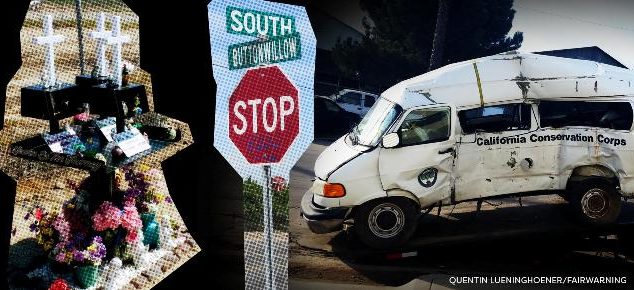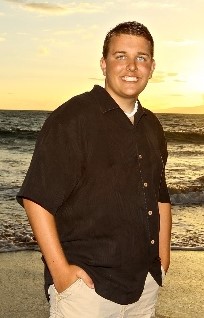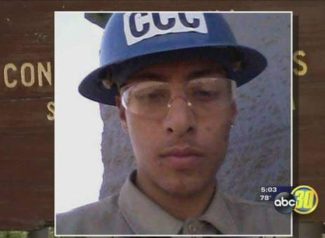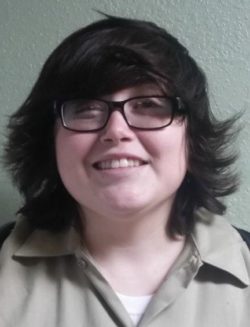News
Conservation Corps missed warning signs before fatal van crash
 Photo illustration by Quentin Lueninghoener, FairWarning.
Photo illustration by Quentin Lueninghoener, FairWarning.Early on Feb. 2, 2016, a van carrying members of the California Conservation Corps paused at a stop sign on a country road near the Central Valley town of Reedley. Then the van rolled into the intersection, where it was broadsided by a 40-ton gravel truck and trailer, killing three corps members and leaving another with catastrophic brain and spinal injuries. The victims, 18 to 21 years old, all were recent recruits – two of them so new that they had yet to collect their first paycheck.
The 20-year-old crew leader driving the CCC van, who survived with moderate injuries, would be found clearly at fault. The weather was good, with visibility of about 10 miles and unobstructed views in all directions. Yet after stopping, the driver unaccountably continued on as the Peterbilt truck, traveling at least 50 mph, rumbled toward him.
“This is really heartbreaking because my son, he was very athletic … He sees childhood friends from his past and he cries.” — Angela Palma
It was the worst day in the 40-year history of the state agency, which puts young adults between 18 and 25 to work on conservation projects on public lands throughout the state. In news reports, grieving families and friends paid tribute to those who perished – Serena Guadarrama, 18, of Fresno, and Justin Vanmeter, 21, and Rhonda Shackelford, 20, of Clovis – and to Ronnie Cruz, 19, of Fresno, who was left unable to speak or move. The few details that emerged seemed to exonerate the CCC. The collision appeared to be a simple case of one person’s carelessness – the kind of inattentive blunder most drivers have made at one time or another, just not with fatal consequences.
Yet facts and circumstances never disclosed until now tell a more complicated story about the CCC’s own role in the fatal collision. Interviews and records obtained by FairWarning under the California Public Records Act reveal warning signs that, if heeded, could have prevented or lessened the tragedy. For example:
–The van’s driver, Nathan L. Finnell, was considered an unsafe driver by some fellow corps members, prone to recklessness and clowning around behind the wheel. On the morning of the crash, his supervisors at the Fresno CCC center were made aware of concerns about his driving but let him drive the crew anyway.
–Safety belts, the most basic safety feature, were not readily available in 11 of 15 seating positions of the 2001 Dodge Ram van – typically because belts and clasps had slipped through cracks in the seats and were lying behind them on the floor, a report by the California Highway Patrol later found. Two of those killed were unbelted and in seats without working restraints, records show. One of the unbelted victims, Guadarrama, was ejected from the van, landing on the side of the road along a chain-link fence.
–CCC paperwork incorrectly indicated that the seat belts were in good shape. Under CCC policy, a safety checklist – called a “Driver Report of Vehicle Condition” – must be filled out to note any needed maintenance and repairs every time a vehicle is taken out. FairWarning reviewed copies of the checklistsfor the van. On 25 separate days leading up to the day of the crash, all components, including the seat belts, were marked OK.

Scene of the California Conservation Corps van crash near Reedley, Calif., that killed three corps members on Feb. 2, 2016. (Photo: Myron Levin)
Following the crash, two state agencies – the California Division of Occupational Safety and Health and the California Highway Patrol – opened investigations, but neither faulted the CCC for failing to maintain working seat belts. The Highway Patrol, in a 117-page report, found Finnell to blame for the accident because of his failure to yield to the truck. It also said he violated a requirement of the state vehicle code that drivers make sure passengers are wearing seat belts.
At least two lawsuits and a string of workers’ compensation cases still are pending. Citing the litigation, the CCC declined to make senior officials available for an interview or answer some specific questions via phone and email.
“We remain deeply saddened over the deaths of three of our Corpsmembers and the critical injury suffered by a fourth,” the CCC said in a statement to FairWarning. “The CCC has always been, and will always be committed to seeking ways to provide safer program working environments for our Corpsmembers and employees.”
Finnell, too, declined to be interviewed. He recently picked up a call from FairWarning while he was driving. Asked if it would be possible to speak at a better time, he said: “I don’t really feel like talking about it much – no thanks.”
The tragedy upended many lives. Some former corps members told FairWarning that they remain haunted by the loss of friends and co-workers and have experienced survivor’s guilt for not finding a way to prevent it. For some family members, time has done little to soothe their sense of loss and bitterness about the brevity of Finnell’s jail sentence – 46 days – and the CCC’s failure to acknowledge its share of the blame.
“It hasn’t gotten better”
“It doesn’t seem like it’s been two years at all,” said Ron Shackelford, whose daughter, Rhonda, was among those killed. Routine life events still bring a painful stab of memory. He recently saw a movie with scenes of a wedding and the bride dancing with her father, “and (I) broke down at that point. … It hasn’t gotten better,” he said.
Angela Palma’s son, Ronnie Cruz, suffered such severe brain and spinal cord injuries that he can’t take care of his basic needs.
“This is really heartbreaking because my son, he was very athletic,” she said. He was “a good young man” who helped take care of his sisters after the death of his father when he was 12.
Believing her son is being shortchanged, Palma repeatedly has antagonized doctors and caregivers over what she sees as too little effort at rehabilitation – admitting to sometimes feeling “very hostile and desperate.”
Cruz can understand things, she says. He has learned to blink twice to signal when he wants to watch TV or hear music.
“He sees childhood friends from his past and he cries,” she said.

Ron Shackelford, whose daughter, Rhonda, died in the California Conservation Corps van crash, says she had complained about Nathan Finnell’s driving a few days before the crash. (Photo by Myron Levin)
***
“Hard work, low pay, miserable conditions, and more!” is the motto of the California Conservation Corps, which was inspired by the Depression-era Civilian Conservation Corps. It is an idealistic throwback to a time when government was widely seen as a positive force in helping people improve their lives — an idea mostly out of fashion today.
Launched in 1976 during Jerry Brown’s first stint as governor, the CCC has given more than 125,000 young people minimum-wage jobs building trails, planting trees and making water and energy efficiency improvements – along with responding to emergencies such as wildfires and floods. Many recruits are from blue-collar or low-income families, with meager job prospects and education. Corps members who aren’t high school graduates must earn their diploma by taking classes along with their work. Those who complete a year of service are guaranteed a scholarship to advance their education.
In their applications, the crash victims stressed their eagerness to join. “I can help and I need to finish high school,” said Ronnie Cruz, adding: “I’m committed, I have perseverance, I get along with others really easily.”
“I will gain experience and skills that will help me after I have finished my service with CCC,” said Rhonda Shackelford, listing her strengths as being “hard working, friendly, really energetic” and ”respectful.”
“I would like to learn more about land conservation and upkeep,” said Justin Vanmeter. “I’m a quick learner, I’m punctual and outgoing.”
Nathan Finnell joined the CCC in 2014 and flourished. “It was through the C’s that he found his calling,” his grandmother later would say during a court appearance.
He was honored as the Fresno center’s Corpsmember of the Year in his first year and was one of about two dozen members across the state to be featured in a CCC brochure. His mini-profile praised his “strong work ethic” and noted that, by earning his commercial driver’s license, he was “aiming for promotion.”
Along with a commercial license, Finnell got his “blue card” – the authorization to transport crews in the CCC’s 15-passenger vans. His promotion to conservationist I, a state civil service job, was announced at a Christmas party in December 2015.
But it turned out that his driving made some on his crew uncomfortable and even fearful. Some said they saw him texting while driving. They told how, for sport, he would suddenly brake and then accelerate to jolt awake drowsy crew members. One time, he drove onto a muddy section of a public park to slide around, almost ramming a bench, according to former crew member Angus McGunigle, who also said he saw Finnell run a stop sign.
“You should have seen what happened”
Rhonda Shackelford, who died three weeks after being hired, had come home livid a few days before the crash, her father said.
“You should have seen what happened today,” Ron Shackelford recalled her saying. ” ‘This idiot blew through a red light.’ … Rhonda wasn’t one to go around talking bad about people,” her father said, so “that made us listen that much more.”

Rhonda Shackelford, 20, of Clovis, Calif., had been in the California Conservation Corps for three weeks when she was killed. (Photo courtesy of Ron Shackelford)
Rhonda’s mother was adamant: The incident needed to be reported. And Rhonda said it had been, “but she might have fibbed because she knew we would have insisted.”
Complaints about Finnell’s driving mainly surfaced after the crash, and it’s unclear how much supervisors knew beforehand. Members of Finnell’s crew were subordinates and friends – two reasons they might have been loath to report him. However, some former corps members said management had to have known about Finnell’s driving.
“It was kind of a joke around the center about him being a bad driver,” said former corps member Candice Madel. “It’s a small, close-knit center. You know everyone pretty much knows everything.”
Corps members are supposed to keep a journal to practice their writing skills, and two weeks before the crash, former crew member Albert Wakefield wrote in his: “It’s putting it lightly to say he (Finnell) can’t drive. Very lightly. I get scared when he drives because he talks on his phone a lot during the trips. He also breaks traffic rules constantly. … His crew worries too. We probably won’t crash. But we might and it’ll be his fault.”
Although journal entries are supposed to be read by supervisors, Wakefield told FairWarning that he didn’t know if this entry ever was read.
But another incident the day before the crash put supervisors on notice.
There was a mechanical problem with the van’s sliding passenger door, making it difficult to close. On Feb. 1, 2016, crew member Daniel Marchetti was wrestling with the door and asked Finnell not to drive away. Before the door was fully closed, Finnell accelerated, jerking the door open and hurting Marchetti’s shoulder, he said.
Trying to be the funny guy
“I don’t believe it was an accident,” he said in an interview. “He was just trying to be the funny guy in the crew.”
There was already tension between Marchetti and Finnell, several corps members said, and that night, Marchetti bashed Finnell on Facebook and, he acknowledged, threatened “tit for tat.”
“I just looked up what code 1144 means. There are 3 confirmed fatalities. This is really bad.” — Email from a CCC official to a colleague.
The next morning, supervisors called in Finnell, Marchetti and others to discuss the door incident and the Facebook post. Marchetti said a supervisor accused him of contriving the shoulder injury to get Finnell in trouble. Then Finnell met privately with supervisors. Afterward, some crew members said Finnell seemed upset.
“I never really found out what they said to Nate,” said former crew member Robert Verdin. “I could tell he was trying to hold back tears and he was trying to hide it from everybody else.”
The crew was headed to the nearby Central Valley town of Dinuba for the second day of a turf removal project. Trailing the van was a CCC pickup hauling a trailer with equipment. To ease tensions, Marchetti had switched places with Rhonda Shackelford to ride in the pickup while she rode in the van. Within an hour, she and two others would be dead.
Terrible as it was, the tragedy could have been much worse. There were only six in the van, counting Finnell – not nearly as many as on an ordinary day. One crew member had been suspended for skipping work. Another, Shayne Johnson, had called in sick, though he later admitted he wasn’t ill. Johnson told FairWarning that he “didn’t necessarily feel like there was going to be an accident,” but had a bad feeling about going to work that day.
Three other crew members were held back at the last minute. Amy Duncan, a supervisor, asked them to stay at the center for blue card driver training.
“Honestly, it really was a miracle that there were only six people” in the van, said McGunigle, one of those held back for the training.
“Nate, don’t do it”
At 8:12 a.m., the van, traveling on South Avenue near Reedley, stopped for at least a couple of seconds at the stop sign at Buttonwillow Avenue, corps member Daniel Lara, who was trailing in the pickup, told the California Highway Patrol.

Justin Vanmeter, 21, of Clovis also was in the corps for only three weeks when he was killed in the crash.
Then the van entered the intersection in the path of the Peterbilt truck, which did not have a stop sign. Marchetti, riding shotgun in the pickup, told the Highway Patrol that he heard Lara say, “Nate, don’t do it, don’t do it” – then looked up to see the crash.
Lara called 911 and his supervisor, and word spread fast. The words “3 confirmed 1144” flashed on a Highway Patrol website.
“I just looked up what code 1144 means,” one CCC official emailed another. “There are 3 confirmed fatalities. This is really bad.”
Finnell and the front-seat passenger, Shaun Christman, 18, escaped with moderate injuries. Christman had dozed off and did not see the crash, and Finnell, briefly knocked unconscious, told Highway Patrol officers that he could not remember what happened. He was tested for alcohol and drugs, and results were negative.
Could Finnell have been talking or texting on his cellphone? On the initial collision report, the “cell phone not in use” box was marked with an X. The only way to know that for sure would be through an eyewitness or getting a court order for phone records – which the Highway Patrol did not do. A Highway Patrol manual directs officers to mark the not-in-use box “if cell phone use is unable to be determined.”
Within hours of the crash, former CCC Director David Muraki emailed the current director, Bruce Saito, to offer condolences and advice.
“Yes, you can be of help,” Saito replied. “How do you deal with and understand something like this?”
Capitol flags were flown at half-staff, and Gov. Jerry Brown issued a statement.
“These three individuals had just embarked on a year of service and had so much ahead of them,” he said. “Our hearts go out to their families, friends and colleagues as they mourn this tremendous loss and our thoughts are also with the others injured today.”
***
Three weeks later, Ron Shackelford stood in the early morning darkness outside the California Conservation Corps center in Fresno, handing out business cards. Shackelford is a tiling contractor, but he was not looking for work. He was seeking information. Enrique Rios, CCC conservation supervisor, emailed a copy of Shackelford’s card with a note to colleagues: “This Gentleman was at the … parking lot passing out his business cards to (corps members) asking them to call him with any info regarding the accident. I believe he is Rhonda’s father.”
A divisive presence
Nathan Finnell returned to work at about the same time, in late February. Agency spokesman Dana Howard told FairWarning that Finnell was not allowed to resume driving. But his presence was divisive. Some corps members did not like having him back. Others felt bad for him.

Ronnie Cruz of Fresno was 19 when he sustained severe brain and spinal cord injuries in the 2016 van crash. (Photo from news report on ABC30 Fresno)
A lot of people held … grudges toward him,” said Robert Verdin, one of the crew members who stayed back for driver training the day of the crash. “I felt like they were leaving a teammate out in the open for the wolves to come and tear up.”
Some corps members said they blamed Daniel Marchetti for instigating a clash that led Finnell to be upset, and possibly distracted, when he took the wheel that day.
Tempers flared in early March at a “Unity Day” retreat in the Sierra Nevada foothills town of North Fork. Finnell was wearing a CCC belt buckle; corps members Candice Madel and Paul Hovland said that when they asked him where he got it, Finnell said, “You have to kill a lot of people.”
Only a month had passed since the crash, and Madel and Hovland were shocked by the callous remark. Each summarized the exchange in written statements. Hovland wrote: “I asked Nate how he got his CCC belt buckle and he semi chuckled and replied ‘you gotta kill alot of people.’ Then went on to explain the website he had got it from etc.”
Madel said that when she voiced her disgust, supervisors said that “they didn’t know the state of mind (Finnell) was in.”
“Then why is he back at work?” she recalled asking. “I felt like they were just … defending him and trying to downplay it.”
A sudden chill
Other corps members weighed in with their own statements, saying they were present but didn’t hear Finnell utter the offensive joke. Madel and Hovland, who later were fired under disputed circumstances, said they felt a chill immediately afterward.
“A lot of people after that didn’t really want to talk to us,” Hovland said.
“I kind of put a target on my back when I did complain,” Madel said. “They didn’t want us talking about the crash or anything, especially with new corps members coming in.”

Logo of the California Conservation Corps
Other corps members left soon after, including Tony-Ray Castellon. He complained about “several safety issues with vehicles currently in-service” at the Fresno center, CCC safety officer Summer Kincaid wrote in an email to other CCC officials. “He said he is afraid to travel to project sites and is uncertain about the qualifications of those conducting the daily Vehicle Safety Inspection.” Castellon told FairWarning that he, too, quit soon after because “I just didn’t trust anything in there anymore.”
Daniel Lara, the pickup driver who reported the crash, also left a few weeks later. “It just didn’t feel the same to me,” he said. “I guess I had a form of survivor’s guilt. … It was very traumatic. ”
Finnell didn’t last long, either. Following the retreat incident, Rios, the conservation supervisor, emailed colleagues: “Nathan’s comments are not helping at all on the healing process here.” Rios feared corps members “felt disrespected about the comment and I can feel the tension now and I just don’t want a major incident to happen.”
On March 8, 2016, Finnell was placed on administrative leave “pending completion of an internal investigation that you may have violated State and/or Departmental policies,” the memo said. He was terminated a month later; officials would not discuss the reasons.
The state Division of Occupational Safety and Health, known as Cal/OSHA, received a complaint from a confidential source that Fresno CCC drivers were not being trained adequately or vans maintained in a safe condition. The agency did not conduct an inspection but directed CCC officials to investigate and provide a response. The CCC sent Cal/OSHA extensive paperwork, including a copy of the agency’s driver training manual and vehicle condition forms for its Fresno vans. Included were copies of the checklists for the Dodge Ram van for the weeks leading up to the crash – with the inaccurate notations that seat belts were OK.
Boilerplate response
In an April 1 letter to the unnamed complainant, Cal/OSHA said it was closing the investigation. “California Conservation Corp (sic) has advised (Cal/OSHA) that the hazard(s) you complained about has/have either been identified and corrected and/or determined not to exist,” the letter said.

Serena Guadarrama, 18, of Fresno was the youngest of the three people killed in the crash. A safety belt was not available where she was seated, and she was ejected from the van. (Photo provided by California Conservation Corps)
Asked to explain the boilerplate response, Cal/OSHA spokesman Lucas Brown said that in cases of work-related vehicle accidents, the agency “generally defers to the California Highway Patrol or another agency with similar jurisdiction to investigate such accidents.”
The California Highway Patrol assigned the probe to its Multidisciplinary Accident Investigation Team. Its 117-page report, issued in July 2016, calculated, among other things, that when the van pulled into the intersection, the truck was 170 feet away but would have had to have been nearly twice as far away – at least 332 feet – for the van to make it safely across. The Highway Patrol also found that safety restraints for 11 of the 15 seating positions in the van “were not readily available for use by the passengers of the vehicle. The major components of the restraints were either under or behind the passenger seats, and appeared to have been in that condition for some time.”
Under the heading “Violations of Law,” the report cited Finnell’s failure to yield the right of way and obey the state vehicle code requirement that drivers ensure that passengers are “restrained by a safety belt.”
Investigators did not look into whether Finnell might have been distracted by a cellphone.
“We have a finite amount of resources,” investigator John Kolter said, adding that it did not seem necessary to find out.
No mystery here
“There’s no doubt what happened,” he said. “There’s no mystery here. The truck was too close … and he pulled out in front of it.”
More than five months passed from the time of the crash to the release of the Highway Patrol report. Only then did CCC officials instruct district directors to check the condition of seat belts in all vehicles. The CCC declined to discuss what it found, citing pending litigation.
“Yes, you can be of help. How do you deal with and understand something like this?” — Email from CCC director Bruce Saito to former agency director David Muraki
Finnell’s driver’s license was suspended in September 2016. He appealed, asking for a restricted license, but was unsuccessful. Supporting his request were two of his former supervisors, Amy Duncan and Miguel Diaz, and the pickup truck driver that day, Lara. According to the hearing record, they “testified in essence that respondent (Finnell) is a safe driver and this accident has caused respondent great distress. They testified they have ridden in the vehicle with respondent and he is a good and safe driver.”
***
Nathan Finnell was charged with three counts of vehicular manslaughter without gross negligence, a misdemeanor, and reached a plea agreement with Fresno County prosecutors.
His sentencing hearing Nov. 7, 2017, which was recorded, was an excruciating event, overflowing with tear-soaked recriminations against Finnell and the conservation corps.
Sherry Guadarrama wept as she described the shattering loss of her daughter, Serena, saying she had once tried to kill herself “so I could be with her again.”
Terrible nightmares
“I’ve had terrible nightmares of how Serena died, how she suffered,” she said. “It haunts me every day. … I hate to go to sleep, I have so much guilt for not being there. I’m still here and she’s not. A parent is not supposed to lose their child.”

CCC Director Bruce Saito. (Photo from California Conservation Corps)
Finnell’s mother, Noelle Finnell Spencer, also wept.
“I want to begin by telling the families and friends of the young people who were killed how sorry we are, and, yes, how sorry Nathan is,” she said. “He never meant for any of this. … You might say, ‘Well, yes, at least he’s still alive’ … but it’s a half-life, a kind of purgatory where he stays locked up in his room in his home most days. … Nathan won’t talk about the accident. He’s going through a rough time. …
“He appears that he is not sorry, but … I know my son. That is a protection. He protects himself that way. … He’s deathly afraid of being locked up. … I know he feels deep sorrow for the lives of your children. … I’ve seen the tears when he thinks no one is looking. … I’ve great faith that your children are in heaven and that everything will work itself in the end. … I pray and ask for peace for all of you. And I pray and ask for forgiveness for my son.”
Amy Duncan, the CCC supervisor, had entered the courtroom holding Finnell by the arm, as though to comfort him – infuriating the parents of the dead. When her time to speak came, Duncan began: “I want to say to families and friends and loved ones how sorry we are.”
“For what? Letting him drive?” one parent shouted. “Why did you let him get into the van and drive our kids?” another yelled. She soon was shouted down and took her seat.
Finnell mumbled a brief apology and the judge pronounced a suspended sentence of 364 days that, with credit for good behavior, worked out to 46 days in jail.
Finnell was out before Christmas, and a few days later his driving privileges were restored.
According to a DMV hearing officer’s summary, Finnell “testified that this was a horrible accident caused because of a mistake made on his part. … He states that the impact from the collision has affected his memory of how this collision occurred. … He states he was not using his GPS or looking at any device that would have caused him to take his eyes off the roadway.”
The apparent contradiction – not remembering anything yet knowing he was not on a cellphone – was not acknowledged.
Legal fallout
Other legal proceedings continue. Because injured workers, with rare exceptions, can’t sue their employers, the families have filed workers’ compensation claims rather than lawsuits against the CCC. In them, they have accused the agency of “serious and willful misconduct” for failing to provide a safe vehicle and employing a reckless driver. In response, the State Compensation Insurance Fund, which is defending the CCC, contends that the three corps members’ deaths and Ronnie Cruz’s injuries were “not due to any act or omission” by the CCC.
Ordinarily, the death of a worker with a single dependent would result in an award of $250,000. Yet, in a strange legal twist, because Serena Guadarrama, Justin Vanmeter and Rhonda Shackelford had no dependents, it’s possible that benefit awards would go into the state’s General Fund to help offset the cost of a program to pay for injuries to disabled workers.
Separately, lawyers for the families recently filed a civil lawsuit against other parties: Finnell; the driver and owner of the Peterbilt truck, on the theory that he could have braked faster; and Fresno County, for failing to make the intersection a four-way stop.
***
To the east of the site where the corps members died, the Sierra Nevada is visible as a gray-blue shadow through the haze. Orange groves and grapevines spread over the adjacent fields. On the side of the road is a memorial topped with three white crosses and stenciled with the words, “Heaven Be The Journey.”
There is a photo and plaque for each of the three youths, along with flowers and figurines of angels, pandas and birds. Above the plaque for Rhonda Shackelford is a bell-shaped trinket from Las Vegas, where her dad was planning to take her on her 21st birthday.
Ron Shackelford comes frequently to make sure the memorial has not been disturbed and is shipshape.
“It gives me time to spend with them and makes me feel like I’m doing something,” he said. “I wasn’t ready to say goodbye, you might say.”
—
Ed’s Note: Myron Levin is the editor of FairWarning, a nonprofit, investigative news organization that focuses on public health, safety and environmental news, and related topics of government and business accountability. Reporter Sophia Bollag contributed to this story.
Want to see more stories like this? Sign up for The Roundup, the free daily newsletter about California politics from the editors of Capitol Weekly. Stay up to date on the news you need to know.
Sign up below, then look for a confirmation email in your inbox.

Same with most drivers of youth vans; drivers should be sowing buttons on sweaters, not driving.